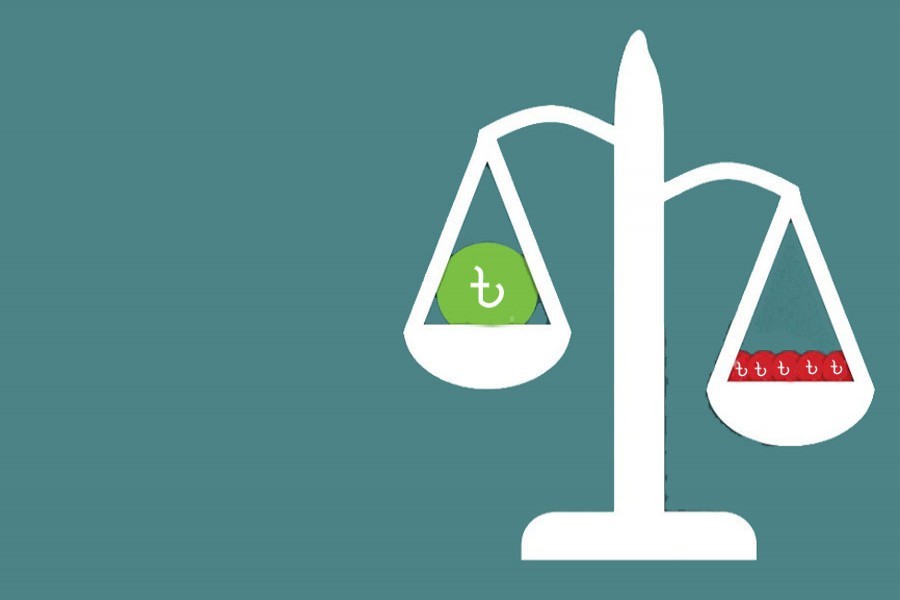Apparently, Bangladesh is going to grapple with rising gini ratio of income inequality. Reportedly the ratio rose from 0.35 in the 1970s to 0.45 in recent periods. All our celebrations of success conceal the hard reality that poverty-stricken Kuril slum lies in the heart of posh Gulshan area. Attempts have long been made in addressing the question of inequality but to no avail.
A major way to help income distribution possibly is through human capital formation of the poor. Arguably this "will equip the poor to get better and higher paying employment. An educated and healthy labor force can also help increase the rate of growth of GDP while improving income distribution". The increased enrolment in primary and secondary schools from poor segment of society are paying dividend. Thus the Seventh Five Year Plan (SFYP) Plan aimed to raise the share of public spending on education and health from 2.2 and 0.8 per cent in FY 2015 to at least 3.0 and 1.2 per cent respectively in 2020. Admittedly, the allocation has to be supported by "major improvement in the delivery of public education and health services through education policies, governance and institutional reforms." All said and done, the fact remains that the share of spending on education and health by the government remains far below what is warranted for sustainable human capital formation.
There is no doubt that at the end of the Plan period, Bangladesh would witness a reduction in inequality over the next five years as more of the children from poor group attended schools and access health services. But in a regime where the rich gets quality education and health services more than the poor, the inequality may not wane but widen. Thus, a girl from kindergarten in urban areas could end up in software services while a girl from rural school would groan working in a garment factory. To nip educational inequality in the bud, society needs to have same type of schools across the board with same curriculum. This is a tall order hardly to be accomplished by policymakers and politicians whose children are educated in kindergartens, private universities or even abroad. Again, within rural areas, solvent parents can pay for tutors while poor parents lack the capacity thus resulting in equality in the access to education. In this context, one would suggest that the government take a lesson from BRAC's experiment with pre-primary and primary schools where access to education for the poorest could be ensured with a sharp eye on the quality of education.
However, the plan to pour in public spending on rural infrastructure such as rural roads, irrigation and flood control may serve to reduce inequality. Availability of rural credit could be another important way to address inequality but the government plans and documents remain silent on the modus operandi excepting a line of appreciation for microcredit revolution that helped the poor with consumption and asset accumulation. The role of public sector in providing rural credit has remained peripheral. To give an example, still one-third of the rural borrowers borrow from informal sources like money lenders, traders, friends/relatives; two-thirds from NGOs and about one-tenth from government and private banks. The whole financial market is poised to help the rich at the expense of the poor.
The third important area for reducing inequality relates to increased spending on social protection, say, from 2.0 percent of GDP in 2015 to 2.3 percent in 2020. One can hardly disagree that spending on social protection is a must for addressing inequality but "there are also important concerns about the quality and targeting of this spending that needs urgent reviews and reforms". By and large, higher spending on education, health, rural infrastructure and social protection would cost an additional 2.5 per cent of GDP - "a seemingly tall order in the present environment of public resource constraint…a strategy to mobilize this additional funding is certainly within the reach of public policy".
First, the government spends roughly 3.0 per cent of GDP on subsidies, of which 2.0 per cent of GDP is on energy. It is our presumption that subsidies in Bangladesh have not been an equalizer as expected e.g., in higher education or agriculture. The energy subsidy is no exception where a miniscule of the poor have access to subsidised energy. The Plan documents assumed that about half of the energy subsidy could be saved through price increases and better targeting for use in social service. Second, increase in personal income tax, value-added tax and local government revenues would be needed to mobilise additional resources for reducing inequality.
While the fiscal policy package could help with additional resources, the on-going 'political policy package' under the umbrella of governance remains to be no less important. We should not be oblivious of the fact that major sources of inequality are loan defaults, land-grabbing and tax evasion. In this case, income distribution can be improved through better governance. Generation of an additional 2.5 per cent of GDP required for social spending would only be effective in a regime of less corruption, better targeting, and quality improvement in public service delivery system. The grievous governance that Bangladesh is faced with may raise the gini ratio of inequality rather than reduce it. This is a fait accompli - the planners propose, the politicians dispose - instilled in inequality question throughout all plan periods. Hope this time, it is a bit different.
Abdul Bayes is a former professor of Economics at Jahangirnagar University and currently an adjunct faculty of East West University. [email protected]


